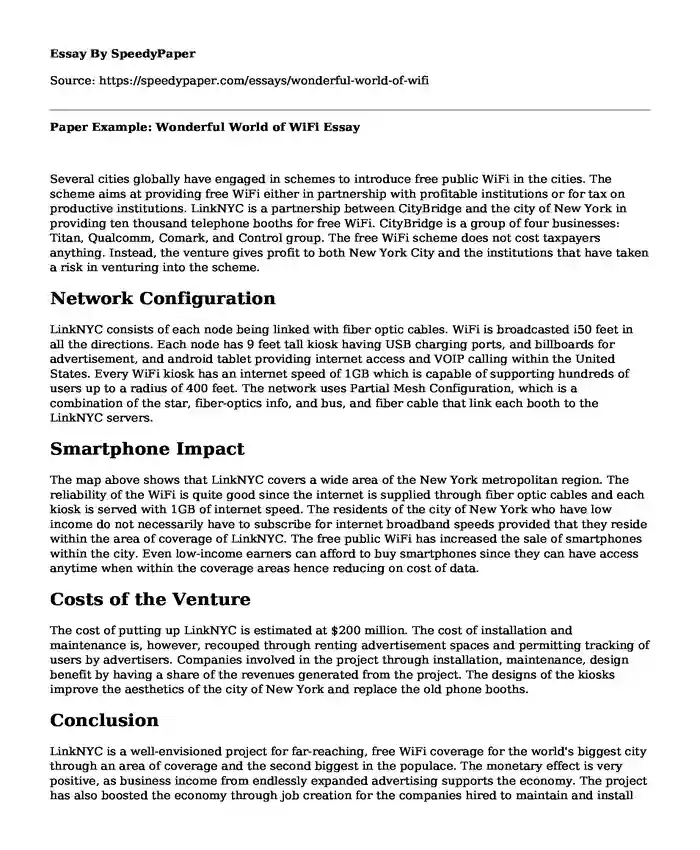
| Type of paper: | Essay |
| Categories: | United States Engineering Internet Information technologies |
| Pages: | 2 |
| Wordcount: | 537 words |
Several cities globally have engaged in schemes to introduce free public WiFi in the cities. The scheme aims at providing free WiFi either in partnership with profitable institutions or for tax on productive institutions. LinkNYC is a partnership between CityBridge and the city of New York in providing ten thousand telephone booths for free WiFi. CityBridge is a group of four businesses: Titan, Qualcomm, Comark, and Control group. The free WiFi scheme does not cost taxpayers anything. Instead, the venture gives profit to both New York City and the institutions that have taken a risk in venturing into the scheme.
Network Configuration
LinkNYC consists of each node being linked with fiber optic cables. WiFi is broadcasted i50 feet in all the directions. Each node has 9 feet tall kiosk having USB charging ports, and billboards for advertisement, and android tablet providing internet access and VOIP calling within the United States. Every WiFi kiosk has an internet speed of 1GB which is capable of supporting hundreds of users up to a radius of 400 feet. The network uses Partial Mesh Configuration, which is a combination of the star, fiber-optics info, and bus, and fiber cable that link each booth to the LinkNYC servers.
Smartphone Impact
The map above shows that LinkNYC covers a wide area of the New York metropolitan region. The reliability of the WiFi is quite good since the internet is supplied through fiber optic cables and each kiosk is served with 1GB of internet speed. The residents of the city of New York who have low income do not necessarily have to subscribe for internet broadband speeds provided that they reside within the area of coverage of LinkNYC. The free public WiFi has increased the sale of smartphones within the city. Even low-income earners can afford to buy smartphones since they can have access anytime when within the coverage areas hence reducing on cost of data.
Costs of the Venture
The cost of putting up LinkNYC is estimated at $200 million. The cost of installation and maintenance is, however, recouped through renting advertisement spaces and permitting tracking of users by advertisers. Companies involved in the project through installation, maintenance, design benefit by having a share of the revenues generated from the project. The designs of the kiosks improve the aesthetics of the city of New York and replace the old phone booths.
Conclusion
LinkNYC is a well-envisioned project for far-reaching, free WiFi coverage for the world's biggest city through an area of coverage and the second biggest in the populace. The monetary effect is very positive, as business income from endlessly expanded advertising supports the economy. The project has also boosted the economy through job creation for the companies hired to maintain and install the system. Complimentary wireless internet is an additional comfort for the city and will build the travel industry. The effect on the individuals who are presently low-income will be positive and will raise the way of life for all. The system is quick and dependable and kept running by a consortium of private associations, so the standard government inadequacy that torments these sorts of endeavors won't be quite a bit of a factor. LinkNYC is the best of its sort anyplace on the planet.
Cite this page
Paper Example: Wonderful World of WiFi. (2023, Feb 14). Retrieved from https://speedypaper.net/essays/wonderful-world-of-wifi
Request Removal
If you are the original author of this essay and no longer wish to have it published on the SpeedyPaper website, please click below to request its removal:
- Free Essay on Intervention Study
- Twelve Characteristics of an Effective Teacher: Essay Example
- Essay Example on Corporate Social Responsibility (CSR) of Walmart
- Contextualization Research - Essay Example on Anthropology
- Nesma Traders Company - Free Essay with Company Overview
- Paper Example: The Quantitative and Qualitative Difference of Personality Disorder
- Essay Example on Creating Effective Web Communications
Popular categories




